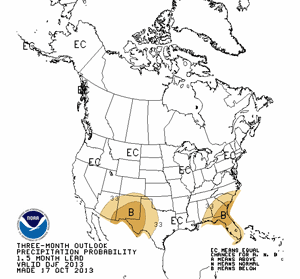

CPC Dec-Jan-Feb Precipitation Outlook
Released October 17, 2013.
Updated November 5, 2013. My mistake -- a spreadsheet range error -- thanks for the heads up Reg! The driest January 1 to November 1 for Downtown Los Angeles was in 1972 with 0.92 inch. Here are the driest ten years for that period:
1. 1972 0.92
2. 2002 1.62
3. 1984 1.93
4. 1961 2.37
5. 1971 2.39
6. 1947 2.45
7. 2013 2.78
8. 1894 2.89
9. 1953 2.89
10. 2007 3.37
An energetic upper level low brought the first widespread precipitation of the rain season to Southern California October 9, with rain at the lower elevations and some snow in the local mountains. Rainfall amounts varied widely, ranging from a trace in some areas to over an inch in the mountains.
Downtown Los Angeles (USC) recorded only 0.04 inch for the storm, bringing the water year rainfall total to 0.13 inch, which is 0.31 inch below normal. Downtown Los Angeles has recorded only 2.76 inches of rain since January 1. This is one of the driest January 1 - October 20 in Los Angeles over the past 135 years! To get out of the bottom ten for calendar year rainfall Los Angeles needs about 3.5 inches of rain by December 31. Normal rainfall for November is 1.04 inches and for December is 2.33 inches.
For months I've been monitoring climate data and forecasts looking for something on which to base a 2013-14 Winter precipitation Outlook. Historically ENSO has played the major role in Southern California rain season weather, with El Nino conditions generally producing wetter weather and La Nina conditions generally drier. But ENSO conditions are currently Neutral and are expected to remain so through the end of the year.
Most climate models forecast slow warming of SSTs in the equatorial Pacific (NINO 3.4 region) over the next several months, but at this time of the year it would be very unusual to have substantial warming. The CPC/IRI ENSO Forecasts from IRI's October Quick Look indicate the probability of an El Nino developing before the end of the year is less than 20% -- and 20% seems high.
One computer model that at times has been forecasting above average precipitation in Southern California this Winter is the Climate Forecast System version 2 (CFSv2). The CFSv2 is fully coupled ocean-atmosphere-land-sea ice model used to forecast parameters such as sea surface temperature, temperature and precipitation rate. While skillful at predicting tropical SSTs, the CFSv2 generally performs very poorly when forecasting precipitation over land, so forecasts such as this earlier one for Dec-Jan-Feb must be viewed somewhat skeptically.
Another glass half-full observation is that the Madden-Julian Oscillation (MJO) has been relatively active this year and if this activity continues it provides recurring opportunities for enhanced U.S. West Coast precipitation. The downside is that it can result in periods of dry weather as well.
With the ocean and atmosphere neutral there's just not much on which to base a rain season forecast. As a result of the government shutdown the release of the official NOAA 2013-14 Winter Outlook has been delayed until November. The October CPC outlook is usually the basis of the initial official NOAA U.S. Winter Outlook. The U.S. Dec-Jan-Feb Precipitation Outlook, released October 17, calls for an equal chance of below average, average, or above average precipitation for all of California. We'll see!
More information about Southern California weather and climate can be found using our WEATHER LINKS page.